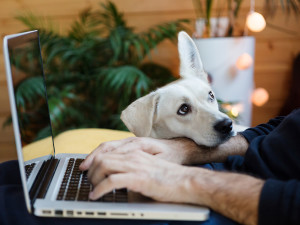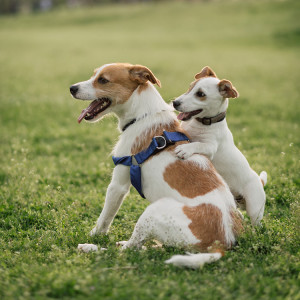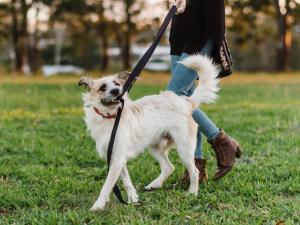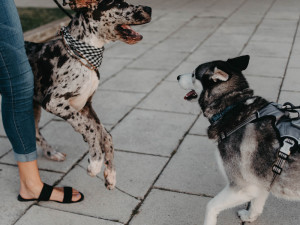
Share Article
In This Article:
How Do Dogs Connect With People? Reasons Why Dogs Paw at You Why Do Dogs Paw at Other Dogs How to Get Your Dog to Stop Pawing Tips for Understanding Dog Body Language Frequently Asked Questions
You're working at your desk minding your own business when there it is ... an adorable yet needy paw settles on your thigh. Your pup is fed, walked, and moments ago was happily gnawing on their favorite toy. So, what gives? Why do dogs paw at us?
Dogs use pawing to express a wide range of emotions, from excitement and love to a gentle nudge for attention or a reminder for dinner time. This instinctual behavior is rooted in their social nature and offers an attention-grabbing way to interact and convey their needs to their human companions. But what should you do — or shouldn’t do — when your dog keeps pawing at you?
How do dogs connect with people?
Even with a language barrier, humans and pups have been besties for literal centuries. How do we do it? By listening to our dogs’ other forms of communication: expressive barks, playful tail wags, and soulful gazes.

“Dogs even use their paws much like we use our hands — to get attention, express a desire for something, or initiate play,” says Dr. Sabrina Kong, a veterinarian at Jules Veterinary Centeropens in new tab in California. In more urgent situations, they might insistently paw.
Turns out, it’s no coincidence that dogs seem to mirror our behaviors, like using their paws to connect with us. Studies show that dogs adjust their communicationopens in new tab based on social dynamics — humans often use physical touch in communication and dogs naturally pick up on the cue.
Reasons why dogs paw at you
Need help deciphering your dog’s pawing? Dr. Kong breaks down the most common reasons for pawing behaviors in dogs:
Attention-seeking
When your dog wants your attention now, they may discover that pawing at you gets your attention the quickest. Kinda like a human toddler poking you while you’re engrossed in a grown-up conversation.
Affection
Dr. Kong says dogs who are pawing simply to say I love you will have a relaxed posture including naturally-positioned ears, a gently wagging tail, and a soft gaze.
Excitement
Did the mail person just arrive and you didn't even flinch? Gasp. Your doggo clearly needs to share the exciting news. Look for tell-tale signs like perked-up ears, a wagging tail, and bouncy movements.
Requesting something
If you're not sure what your dog needs, it's always a good idea to run through your basic care checklist, like when you took them out last, if they had their morning play sesh, or if dinnertime crept up without your realizing.
Training reinforcement
If your dog paws at you and you respond by patting their head or giving them a toy, they’re more likely to keep pawing at you. That's positive reinforcement. It’s a good tool in reward-based training but a slippery slope when giving in to unwanted behaviors.
Stress or anxiety
When your dog feels anxious or stressed, pawing can be their way of seeking comfort and security, similar to how we might hold a loved one’s hand. However, be mindful of signs like tense body language, avoidance of eye contact, or growling, which could indicate aggression or fear. Either way, it's important to address the underlying anxiety rather than simply responding to your pup’s pawing.
Play
Playful pups express themselves differently. Some paw excitedly, while others opt for the classic play bow. Even if you’ve only got fifteen minutes before your next Zoom meeting, it might be time for a quick break. No time to spare until your after-work play session? A long-lasting chew toy or challenging puzzle can help keep your dog busy.
Medical issues
If the pawing behavior is out of the norm for your dog, accompanied by other changes such as a lack of appetite, increased vocalizations, or lack of interest in their favorite activities, it could point to underlying health conditions. Consult your veterinarian to rule out any medical issues before caulking the pawing up to behavioral needs.
Why do dogs paw at other dogs?
Figuring out what your dog is up to is all about context and body language. Some dogs paw at other dogs as a playful gesture, although it may come off as rude to some playmates. This behavior is more often seen in smaller dogs who don’t like to play rough or puppies or are still learning proper etiquette. Playful pawing is accompanied by friendly body language, such as:
Bowing down, with the rump in the air and a wagging tail
Relaxed facial muscles, possibly displaying a ‘grin” or an open mouth
Perked up ears
Playful barks
On the other hand, a dog may paw at another as a sign of dominance or to warn them to back away. This is especially true if you spot your dog placing their paws on another dog’s shouldersopens in new tab. Watch for these warning signs that indicate a not-so-friendly interaction:
Avoiding eye contact
Ears pinned back
Tight facial expression, possibly with a clenched jaw or bared teeth
Raised hair along the back
Low or tucked tail
Growling
How to get your dog to stop pawing at you
If your dog’s pawing is getting disruptive, pushing them away or otherwise punishing them can be confusing to them. Even worse, a negative reaction could frighten them and damage your relationship. Instead, Dr. Kong recommends the below strategies:
Train alternative behaviors: Teach your dog to calmly “sit” or “stay” before receiving attention or treats.
Ignore and reward: Ignore pawing (unless anxiety-related) and reward calm behavior instead.
Establish a routine: If your dog knows when to expect walks, meals, and playtime, it can reduce begging and pawing.
Ask a pro for help: When the pawing is persistent, disruptive, or coupled with signs of anxiety, it might be time to ask a professional dog trainer or a veterinary behaviorist for help. “They can work with you and your dog to develop a training plan that addresses the underlying issues, ensuring that your dog's needs are met in a manner that's healthy and respectful to you and your pet,” Dr. Kong says.
Tips for understanding your dog’s body language
Where things go wrong is when we misinterpret a behavior as annoying or bad. If you want a better relationship with your dog (and don't we all), take the time to learn about how dogs communicate:
Explore the reasons behind your dog’s behaviors rather than immediately labeling them.
Pay attention to subtle cues such as tail wags, ear twitches, and barks for clues into your dog’s mood and intentions.
Consider the surrounding situation and other contextual cues for a complete picture.
FAQs
Why does my dog paw at me while sleeping?
If your dog is pawing at you while you sleep, they might be trying to wake you up for playtime or attention. Alternatively, they could be hearing something unusual and are trying to let you know. But if your dog is lying nearby with a paw resting on you, it’s a way for them to bond and feel safe. Dogs also rest in close contact with other dogsopens in new tab they’re socially bonded to. In other words, you’re part of the pack.
What does it mean when your dog paws you back?
Dogs pick up on our social cues. Because humans use touch to connect, your dog might be “talking back.” It may be their way of showing affection or even to ask for more pets.
Why does my dog paw at me when I stop petting them?
Basically, your dog is saying, “Please keep petting me, thanks!”
References
“APA PsycNet.” Psycnet.apa.org, psycnet.apa.org/record/2017-21968-001opens in new tab.
Kuhne, Franziska, et al. “Effects of Human–Dog Familiarity on Dogs’ Behavioural Responses to Petting.” Applied Animal Behaviour Science, vol. 142, no. 3-4, Dec. 2012, pp. 176–181, https://doi.org/10.1016/j.applanim.2012.10.003opens in new tab.
Kuhne, Franziska, et al. “Emotions in Dogs Being Petted by a Familiar or Unfamiliar Person: Validating Behavioural Indicators of Emotional States Using Heart Rate Variability.” Applied Animal Behaviour Science, vol. 161, Dec. 2014, pp. 113–120, https://doi.org/10.1016/j.applanim.2014.09.020opens in new tab. Accessed 26 June 2021.
Paasovaara, Susanna, et al. “The Secret Life of My Dog.” Proceedings of the 13th International Conference on Human Computer Interaction with Mobile Devices and Services - MobileHCI ’11, 2011, https://doi.org/10.1145/2037373.2037409opens in new tab.
Rezac, Petr, et al. “Factors Affecting Dog Jumping on People.” Applied Animal Behaviour Science, vol. 197, Dec. 2017, pp. 40–44, https://doi.org/10.1016/j.applanim.2017.09.008opens in new tab.
Wells, Deborah L. “Paw Preference as a Tool for Assessing Emotional Functioning and Well-Being in Domestic Dogs and Cats: A Review.” Applied Animal Behaviour Science, vol. 236, Nov. 2020, p. 105148, https://doi.org/10.1016/j.applanim.2020.105148opens in new tab.

Janelle Leeson
Janelle Leeson is a Portland, Oregon-based freelance writer. Her work has been featured in magazines such as Inside Your Dog’s Mind, Inside Your Cat’s Mind, Paw Print, and Real Simple, and on Adopt-A-Pet, Insider Reviews, Forbes Vetted, Forbes Advisor, Readers Digest, NBC Select, Shop Today, PetMD, Chewy Education, Spruce Pets, Daily Paws, and The Bump.
She is a three-time certificate of excellence winner (via the Cat Writers’ Association) and is a two-time panelist at the American Society of Journalists and Authors annual conference. Her work focuses on pet behavior, general care, and nutrition, pet product testing and buying guides, exotic pet behavior, general care, and nutrition, parenting product testing and buying guides.
Related articles
Why Does Your Dog Lick Your Other Dog’s Ears?
That’s cute... sort of?
Does Your Dog Think Every Day Is Hump Day? Dog Humping and How to Stop It.
In moderation, it’s normal. Excessively? It’s not.
![Scruffy dog tugging on leash as owner is pulling it]()
How to Change the Way You Think About Your Dog’s Behavior
Instead of focusing on the negatives, here’s what you should do instead.
![Great Dane puppy and Husky meeting on leash out side.]()
Understanding Reactivity and Aggression in Dogs: Two Very Different Things
Turns out, even experts have a hard time defining these terms.
![Pet parent comforting anxious dog by holding their paw]()
How to Help an Anxious Dog
Easy ways to calm your pup’s nerves.
![Dog laying on the ground guarding toy in mouth]()
How to Get Your Dog to Stop Resource Guarding Their Stuff
If your dog growls when you get near their food or toys, read this right now.








